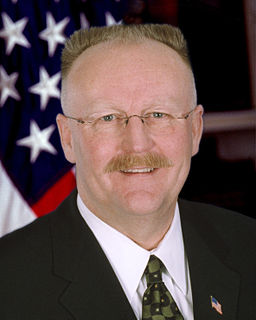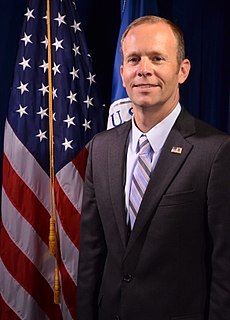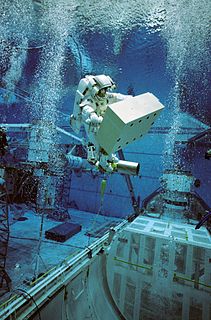
The Federal Emergency Management Agency (FEMA) is an agency of the United States Department of Homeland Security, initially created by Presidential Reorganization Plan No. 3 of 1978 and implemented by two Executive Orders on April 1, 1979. The agency's primary purpose is to coordinate the response to a disaster that has occurred in the United States and that overwhelms the resources of local and state authorities. The governor of the state in which the disaster occurs must declare a state of emergency and formally request from the president that FEMA and the federal government respond to the disaster. The only exception to the state's gubernatorial declaration requirement occurs when an emergency or disaster takes place on federal property or to a federal asset—for example, the 1995 bombing of the Alfred P. Murrah Federal Building in Oklahoma City, Oklahoma, or the Space Shuttle Columbia in the 2003 return-flight disaster.
Earthquake preparedness is a set of measures taken at the individual, organisational and societal level to minimise the effects of an earthquake. Preparedness measures can range from securing heavy objects, structural modifications and storing supplies, to having insurance, an emergency kit, and evacuation plans.

James Lee Witt is a former director of the Federal Emergency Management Agency (FEMA), during the tenure of U.S. President Bill Clinton and is often credited with raising the agency's level of professionalism and ability to respond to disasters.
Emergency management is the organization and management of the resources and responsibilities for dealing with all humanitarian aspects of emergencies. The aim is to reduce the harmful effects of all hazards, including disasters.

The Medical Reserve Corps (MRC) is a network in the U.S. of community-based units initiated and established by local organizations to meet the public health needs of their communities. It is sponsored by the Office of the Assistant Secretary for Preparedness and Response (ASPR). The MRC consists of medical and non-medical volunteers who contribute to local health initiatives, such as activities meeting the Surgeon General's priorities for public health, and supplement existing response capabilities in time of emergency. The MRC provides the structure necessary to pre-identify, credential, train, and activate medical and public health volunteers.
Most emergency management in the United States is done at the local and state level. The Department of Homeland Security has attempted to standardize equipment, organizational structures, and terminology to create better response and preparedness to large and small-scale disasters across the country. The National Incident Management System is a collection of principles and methods that can be utilized by local, state, federal emergency managers as well as the private sector and NGOs. NIMS aims to better improve the nation's response to emergencies. Its goal is a better system that can more efficiently allocate resources in the event of a disaster and facilitate cooperation among diverse entities and agencies. Large-scale disasters in the past in the U.S. suffered from a lack of solid coordination and authority, as well as different entities utilizing different lingo when communication which led to confusion. NIMS attempts to solve these issues. To that end, FEMA developed the National Incident Management System (NIMS).
The National Flood Insurance Program (NFIP) is a program created by the Congress of the United States in 1968 through the National Flood Insurance Act of 1968. The program enables property owners in participating communities to purchase insurance protection, administered by the government, against losses from flooding, and requires flood insurance for all loans or lines of credit that are secured by existing buildings, manufactured homes, or buildings under construction, that are located in a community that participates in the NFIP.

Joe M. Allbaugh is an American political figure in the Republican Party. After spending most of his career in Oklahoma and Texas, Allbaugh came to national prominence working for Texas governor George W. Bush and helping manage his 2000 presidential election campaign. Allbaugh then became Bush's Director of the Federal Emergency Management Agency (FEMA) beginning in February 2001. He served until FEMA's transfer into the newly created Department of Homeland Security, after which he resigned in March 2003. He was appointed as the interim Director of the Oklahoma Department of Corrections by the state Board of Corrections, effective January 11, 2016. On July 6, 2016 the Oklahoma Board of Corrections voted unanimously to make his appointment permanent and set his salary at $185,000. Allbaugh has pointed out his department "is not a listing ship, it is a sinking ship.".
The National Response Plan (NRP) was a United States national plan to respond to emergencies such as natural disasters or terrorist attacks. It came into effect in December 2004, and was superseded by the National Response Framework on March 22, 2008.

The American Red Cross (ARC), also known as The American National Red Cross, is a humanitarian organization that provides emergency assistance, disaster relief, and disaster preparedness education in the United States. It is the designated US affiliate of the International Federation of Red Cross and Red Crescent Societies and the United States movement to the International Red Cross and Red Crescent Movement.

The Disaster Preparedness and Response Team is a non-governmental organisation (NGO) established in Pakistan in November 2005 following the Pakistan Quake. However it was not registered as a voluntary agency until 2006. It is composed of civilian volunteers who give some of their time to train and in major emergencies act as volunteer disaster workers.
The Massachusetts Emergency Management Agency (MEMA) is a Commonwealth of Massachusetts agency. The Massachusetts Emergency Management Agency is the Agency that coordinates federal, state, local, and private resources throughout the Commonwealth during times of disasters and emergencies.

A FEMA Urban Search and Rescue Task Force is a team of individuals specializing in urban search and rescue, disaster recovery, and emergency triage and medicine. The teams are deployed to emergency and disaster sites within six hours of notification. The Federal Emergency Management Agency (FEMA) created the Task Force concept to provide support for large scale disasters in the United States. FEMA provides financial, technical and training support for the Task Forces as well as creating and verifying the standards of Task Force personnel and equipment.

The effects of Hurricane Isabel in Delaware resulted in one of only thirteen presidential disaster declarations for the state of Delaware. Hurricane Isabel formed from a tropical wave on September 6, 2003 in the tropical Atlantic Ocean. It moved northwestward, and within an environment of light wind shear and warm waters it steadily strengthened to reach peak winds of 165 mph (265 km/h) on September 11. After fluctuating in intensity for four days, Isabel gradually weakened and made landfall on the Outer Banks of North Carolina with winds of 105 mph (165 km/h) on September 18. It quickly weakened over land and became extratropical over Pennsylvania the next day. The storm's center remained to the south and west of Delaware, and was about 175 miles (280 km) from Delaware at its closest approach. At that time, Isabel was a strong tropical storm located in central Virginia.

The Emergency Management Institute (EMI) of the United States Federal Emergency Management Agency serves as the national focal point for the development and delivery of emergency management training to enhance the capabilities of state, territorial, local, and tribal government officials; volunteer organizations; FEMA's disaster workforce; other Federal agencies; and the public and private sectors to minimize the impact of disasters and emergencies on the American public. EMI curricula are structured to meet the needs of this diverse audience with an emphasis on separate organizations working together in all-hazards emergencies to save lives and protect property. Particular emphasis is placed on governing doctrine such as the National Response Framework (NRF), National Incident Management System (NIMS), and the National Preparedness Guidelines. EMI is fully accredited by the International Association for Continuing Education and Training (IACET) and the American Council on Education (ACE). The instruction is based upon the principles of Emergency Management and instructional systems design, which create a framework within whole communities to reduce vulnerability to hazards and to cope with disasters. EMI develops courses and implements training delivery systems to include residential onsite training; offsite delivery in partnership with Emergency Management training systems, colleges, and universities; and technology-based mediums to conduct individual training courses for Emergency Management and Response personnel across the United States.

William Craig Fugate is the former administrator of the Federal Emergency Management Agency. As Florida Director for the Emergency Management Division, he oversaw the "Big 4 of '04" and as the Administrator for the Federal Emergency Management Agency, he organized recovery efforts for a record of eighty-seven disasters in 2011.
In the United States, mountain rescue is handled by professional teams within some national parks and by volunteer teams elsewhere. Volunteer teams are often members of the Mountain Rescue Association (MRA).

The Waffle House Index is an informal metric used by the Federal Emergency Management Agency (FEMA) to determine the effect of a storm and the likely scale of assistance required for disaster recovery.
If you get there and the Waffle House is closed? That's really bad...

Robert J. Fenton Jr, also Bob Fenton, is an American governmental official who worked for the Federal Emergency Management Agency (FEMA) in 1996 and was appointed Regional Administrator for FEMA Region IX: Arizona, California, Hawaii, Nevada, and the Pacific Islands in July 2015. He had a leadership role in the development of the National Incident Management System and the National Response Framework.

William Brockmann Long is an American emergency manager who serves as the administrator of the Federal Emergency Management Agency (FEMA). He was appointed to the position by President Donald Trump in April 2017 and confirmed by the United States Senate in June 2017.















